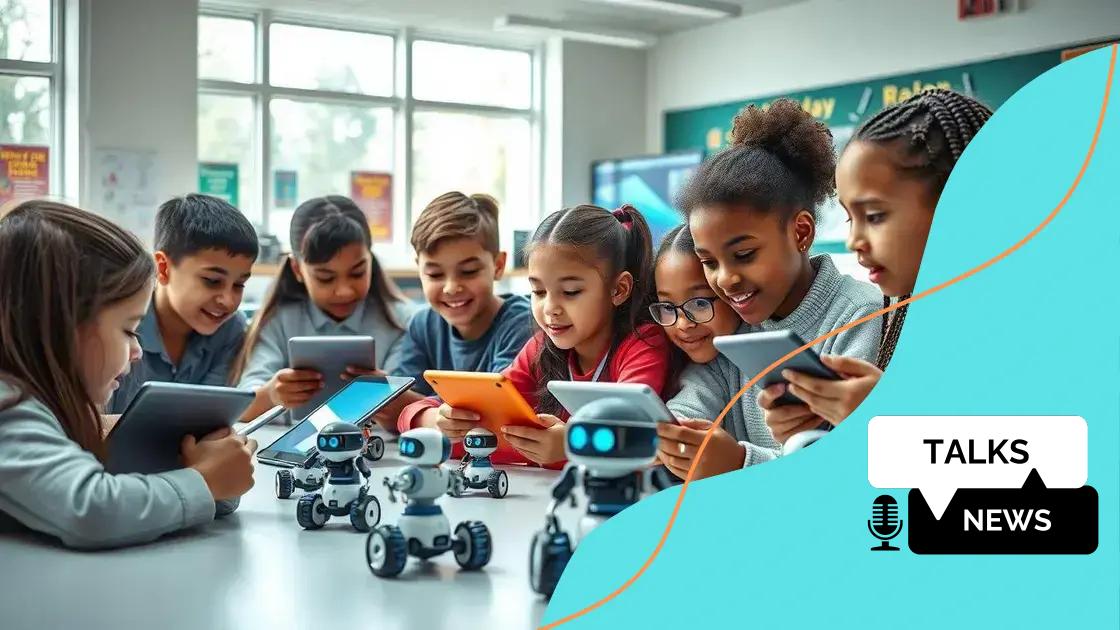AI-driven special education tools reshape learning

AI-driven special education tools enhance learning by personalizing educational experiences, providing real-time data analytics for teachers, and fostering collaborative environments for students with unique needs.
AI-driven special education tools are paving the way for a more inclusive and engaging learning environment. Have you considered how these technologies could change the dynamics of education? Let’s dive into the potential they hold for educators and students alike.
Understanding AI-driven educational tools
Understanding AI-driven educational tools is essential for educators looking to enhance student learning experiences. These tools utilize artificial intelligence to tailor education based on individual needs, making learning more effective.
What Are AI-driven Educational Tools?
AI-driven educational tools include software and applications that use algorithms to analyze student performance and adapt instructional methods accordingly. They can assist in various areas, such as:
- Personalizing learning experiences
- Identifying student strengths and weaknesses
- Providing real-time feedback to students and teachers
- Automating administrative tasks for educators
By leveraging data, these tools create a roadmap for each student’s success, offering support where it’s most needed. They can easily integrate into existing curriculums, enhancing traditional teaching methods rather than replacing them.
Benefits of AI in the Classroom
The incorporation of AI tools in the classroom brings numerous benefits. Firstly, it empowers teachers by providing insights into each student’s learning behavior. This helps educators adapt their teaching styles to fit the needs of their students. As a result, lessons become more engaging and relevant.
Additionally, AI-driven educational tools foster a more inclusive environment. Students who may struggle with traditional methods often find these approaches more engaging. The tools also promote collaborative learning, where peers can work together on assignments, further enhancing understanding.
Ultimately, the goal of these tools is to boost student achievement. With personalized learning experiences, students can work at their own pace and feel more invested in their education.
The impact of AI on individualized learning
The impact of AI on individualized learning is profound as it tailors education to meet each student’s unique needs. With the use of AI-driven tools, teachers can provide personalized experiences that improve engagement and outcomes.
How AI Personalizes Learning
AI analyzes data from students’ interactions, helping educators understand their learning styles and preferences. This leads to more effective lesson plans that resonate with each learner. For instance, students may receive custom content that matches their reading level or interests. Some key benefits include:
- Real-time adjustments to teaching methods
- Customized assignments and assessments
- Targeted support for struggling students
- Enhanced motivation and participation
This approach not only boosts students’ confidence but also encourages them to take ownership of their learning journey. As a result, classrooms become more dynamic and interactive, fostering an environment where every student can thrive.
Examples of AI in Action
After implementing AI tools in the classroom, many educators have noticed significant improvements. For example, platforms that adapt to student performance can suggest tailored resources that help fill knowledge gaps. Schools have reported impressive outcomes, including:
- Higher student grades
- Increased retention rates
- More effective collaboration skills among peers
AI-driven education is rapidly evolving, and as it advances, its ability to customize learning experiences will only improve. This trend emphasizes the importance of integrating technology effectively in educational settings.
Benefits for teachers and students

The benefits of AI-driven special education tools extend to both teachers and students, making the educational experience more rewarding for everyone involved. These tools help create a more engaging learning environment and facilitate better communication.
Advantages for Teachers
Teachers can greatly benefit from utilizing AI tools in their classrooms. By automating routine tasks, teachers can focus more on instruction and student interaction. Some specific advantages include:
- Time-saving features for grading and feedback
- Access to detailed analytics on student performance
- Support in identifying students who need extra help
- Tools for creating customized lesson plans
This technology empowers educators to tailor their teaching strategies to better fit their class dynamics. With insights gained from AI analytics, teachers can modify their approaches based on real-time data.
Impact on Student Engagement
For students, AI-driven tools foster a deeper understanding of subjects through personalized learning experiences. Students are more likely to engage with the material when it is tailored to their interests and abilities. These tools can adapt content to the pace of each learner, making education less intimidating and more fun.
Additionally, they provide opportunities for collaborative learning. Students can work together on projects powered by AI, promoting teamwork and enhancing social skills. This interaction not only boosts confidence but also enriches the learning experience.
As a result, both teachers and students enjoy the advantages of a more interactive, efficient, and effective educational landscape.
Real-life case studies of AI in special education
Real-life case studies of AI in special education reveal how technology can transform learning experiences for students with unique needs. Educators are discovering creative ways to utilize AI tools to enhance classroom dynamics.
Case Study 1: Personalized Learning Platforms
In one school district, teachers integrated a personalized learning platform that uses AI to adapt content based on individual student’s strengths and weaknesses. This platform enabled instructors to see which areas students struggled with and provided tailored resources immediately. It resulted in:
- Improved student engagement
- Significant increases in test scores
- A more collaborative learning environment
Students reported feeling more confident as the lessons became focused on their specific needs, making learning more enjoyable.
Case Study 2: AI Tutors for Diverse Learners
Another inspiring example involved the use of AI-powered tutoring systems. These systems assisted students with learning disabilities by offering practice exercises and targeted help through interactive interfaces. Teachers noted how these AI tutors allowed for more personalized support, which led to:
- Enhanced student independence
- Better time management during tasks
- Increased motivation among students
By analyzing individual student data, these tools provided recommendations that focused on specific areas for improvement, allowing for more effective study sessions.
Overall, these case studies illustrate that AI-driven solutions are not just improving individual student performance but are also redefining the role of educators. As more schools adopt AI technologies, the future of special education looks increasingly promising, providing tailored support to each learner.
Future trends in special education technology
The future trends in special education technology are exciting and hold great promise for enhancing learning. As innovation continues to evolve, schools are adopting new tools that make education accessible to all students.
Advancements in AI and Machine Learning
AI and machine learning are at the forefront of these advancements. These technologies can analyze student data to provide personalized learning experiences tailored to each individual’s needs. Educators can use these insights to create customized lesson plans that adapt as students progress. Some emerging trends include:
- AI-driven assessments for real-time feedback
- Intelligent tutoring systems that adjust to learning styles
- Enhanced speech recognition technology for communication
This data-driven approach not only supports student achievement but also helps teachers make informed decisions.
Integration of Virtual and Augmented Reality
Virtual reality (VR) and augmented reality (AR) are transforming the way students interact with learning materials. These immersive technologies create engaging learning environments where students can explore concepts in 3D. For example, students can take virtual field trips or simulate real-world scenarios, which helps enhance understanding.
AR can overlay information in the real world, providing additional context and support. This can particularly benefit students with special needs, offering them new ways to engage with the curriculum.
Focus on Collaborative Learning
Future technologies will increasingly emphasize collaborative learning. Tools that promote teamwork enable students to interact and learn from one another. This collaboration fosters social skills and allows students to share their unique perspectives.
As technology continues to develop, the role of educators will shift towards facilitating these collaborative experiences, helping to guide students in their learning journey.
All these trends indicate a promising future for special education, making it more inclusive and effective for diverse learners. With continuous advancements in technology, we can ensure that every student has access to quality education tailored to their needs.
FAQ – Frequently Asked Questions about AI-driven Special Education Tools
How do AI-driven tools enhance personalized learning?
AI-driven tools analyze student data to tailor learning experiences, making education more effective and engaging for each student.
What are some benefits of using AI in special education?
Benefits include improved student engagement, tailored instructional strategies, and support for teachers in monitoring student progress.
Can AI tools support teachers in the classroom?
Yes, AI tools automate administrative tasks and provide analytics that help teachers identify students’ needs quickly.
What future trends should we expect in special education technology?
Future trends include advancements in AI, increased use of virtual and augmented reality, and a focus on collaborative learning experiences.





